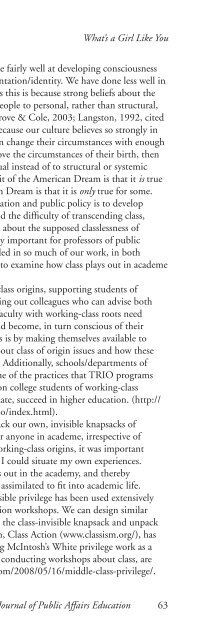WINTER 2012 - National Association of Schools of Public Affairs and ...
WINTER 2012 - National Association of Schools of Public Affairs and ...
WINTER 2012 - National Association of Schools of Public Affairs and ...
Create successful ePaper yourself
Turn your PDF publications into a flip-book with our unique Google optimized e-Paper software.
Techniques in Teaching Statistics<br />
<strong>of</strong> research in their decision-making processes, resulting in improved policy<br />
outcomes. The results <strong>of</strong> this research imply that improving the way in which<br />
practitioners use research is not a single-actor problem or a matter <strong>of</strong> “changing<br />
the other side” (Shapiro et al., 2007, p. 261); the solution might very well<br />
involve the interaction <strong>of</strong> researchers, educators, <strong>and</strong> practitioners. This research<br />
recognizes that the tension between the producers <strong>and</strong> the consumers <strong>of</strong> research<br />
should be used to identify ways to coproduce actionable knowledge <strong>of</strong> high<br />
quality <strong>and</strong> relevance for practice, as suggested by Van de Ven <strong>and</strong> Johnson<br />
(2006), <strong>and</strong> to train current <strong>and</strong> future consumers <strong>of</strong> research. Ultimately, as<br />
Shapiro et al. (2007) suggest, if all the actors participate in the process, this<br />
process will strengthen the relationship between research <strong>and</strong> practice.<br />
ACKNOWLEDGMENTS<br />
We gratefully acknowledge the contributions to this paper by Dr. George P.<br />
Richardson <strong>and</strong> Dr. John Rohrbaugh <strong>and</strong> the recommendations provided by<br />
three anonymous reviewers <strong>and</strong> the editorial board <strong>of</strong> JPAE.<br />
FOOTNOTES<br />
1 This manuscript has been created by UChicago Argonne, LLC, Operator <strong>of</strong> Argonne <strong>National</strong><br />
Laboratory (“Argonne”). Argonne, a U.S. Department <strong>of</strong> Energy Office <strong>of</strong> Science laboratory, is<br />
operated under Contract No. DE-AC02-06CH11357. The U.S. Government retains for itself,<br />
<strong>and</strong> others acting on its behalf, a paid-up, nonexclusive, irrevocable worldwide license in said<br />
article to reproduce, prepare derivative works, distribute copies to the public, <strong>and</strong> perform publicly<br />
<strong>and</strong> display publicly, by or on behalf <strong>of</strong> the Government.<br />
2 See Bisgaard (1991) <strong>and</strong> Sowey (1995) for examples <strong>of</strong> experiential learning with statistics.<br />
3 The final version <strong>of</strong> the questions was developed after pre-testing <strong>and</strong> pilot testing with several<br />
colleagues <strong>and</strong> statistics instructors.<br />
4 Details on the computations for the prioritization step are available upon request.<br />
REFERENCES<br />
Ack<strong>of</strong>f, R. L. (1974). Redesigning the future: A systems approach to societal problems. New York: John<br />
Wiley & Sons.<br />
Adams, G. B., & White, J. D. (1994). Dissertation research in public administration <strong>and</strong> cognate<br />
fields: An assessment <strong>of</strong> methods <strong>and</strong> quality. <strong>Public</strong> Administration Review, 54(6), 565–576.<br />
Aguado, N. A. (2009). Teaching research methods: Learning by doing. Journal <strong>of</strong> <strong>Public</strong> <strong>Affairs</strong><br />
Education, 15(2), 251–260.<br />
Alder, M., & Ziglio, E. (1996). Gazing into the oracle: The Delphi method <strong>and</strong> its application to the social<br />
policy <strong>and</strong> public health. Bristol, PA: Jessica Kingsley.<br />
Journal <strong>of</strong> <strong>Public</strong> <strong>Affairs</strong> Education 131

















